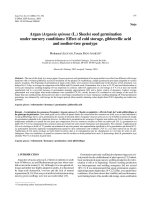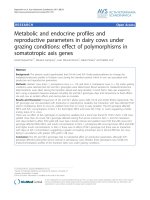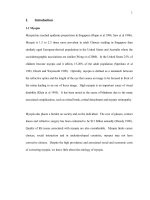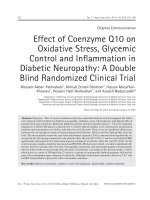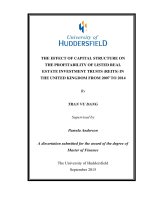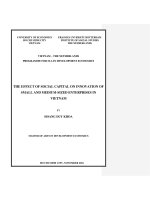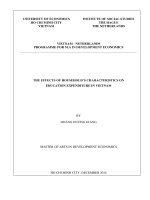Equilibria in cobalt(II)–amino acid– imidazole system under oxygen-free conditions: Effect of side groups on mixed-ligand systems with selected L-α-amino acids
Bạn đang xem bản rút gọn của tài liệu. Xem và tải ngay bản đầy đủ của tài liệu tại đây (1.62 MB, 12 trang )
Woźniczka et al. Chemistry Central Journal (2016) 10:14
DOI 10.1186/s13065-016-0160-5
RESEARCH ARTICLE
Open Access
Equilibria in cobalt(II)–amino acid–
imidazole system under oxygen‑free conditions:
effect of side groups on mixed‑ligand systems
with selected L‑α‑amino acids
Magdalena Woźniczka1, Andrzej Vogt2 and Aleksander Kufelnicki1*
Abstract
Background: Heteroligand Co(II) complexes involving imidazole and selected bio-relevant L-α-amino acids of four
different groups (aspartic acid, lysine, histidine and asparagine) were formed by using a polymeric, pseudo-tetrahedral, semi-conductive Co(II) complex with imidazole–[Co(imid)2]n as starting material. The coordination mode in the
heteroligand complexes was unified to one imidazole in the axial position and one or two amino acid moieties in the
appropriate remaining positions. The corresponding equilibrium models in aqueous solutions were fully correlated
with the mass and charge balance equations, without any of the simplified assumptions used in earlier studies. Precise
knowledge of equilibria under oxygen-free conditions would enable evaluation of the reversible oxygen uptake in the
same Co(II)–amino acid–imidazole systems, which are known models of artificial blood-substituting agents.
Results: Heteroligand complexes were formed as a result of proton exchange between the two imidazole molecules found in the [Co(imid)2]n polymer and two functional groups of the amino acid. Potentiometric titrations were
confirmed by UV/Vis titrations of the respective combinations of amino acids and Co-imidazole. Formation of MLL′
and ML2L′ species was confirmed for asparagine and aspartic acid. For the two remaining amino acids, the accepted
equilibrium models had to include species protonated at the side-chain amine group (as in the case of lysine: MLL′H,
ML2L′H2, ML2L′H) or at the imidazole N1 (as in the case of histidine: MLL′H and two isomeric forms of ML2L′). Moreover, the Δlog10 β, log10 βstat, Δlog10 K, and log10 X parameters were used to compare the stability of the heteroligand
complexes with their respective binary species. The large differences between the constant for the mixed-ligand
complex and the constant based on statistical data Δlog10 β indicate that the heteroligand species are more stable
than the binary ones. The parameter Δlog10 K, which describes the influence of the bonded primary ligand in the
binary complex CoII(Himid) towards an incoming secondary ligand (L) forming a heteroligand complex, was negative
for all the Amac ligands (except for histidine, which shows stacking interactions). This indicates that the mixed-ligand
systems are less stable than the binary complexes with one molecule of imidazole or one molecule of amino acid, in
contrast to Δlog10 β, which deals with binary complexes CoII(Himid)2 and CoII(AmacH−1)2 containing two ligand molecules. The high positive values of the log10 X disproportionation parameter were in good agreement with the results
of the Δlog10 β calculations mentioned above.
*Correspondence:
1
Department of Physical and Biocoordination Chemistry, Faculty
of Pharmacy, Medical University of Łódź, Muszyńskiego 1, 90‑151 Łódź,
Poland
Full list of author information is available at the end of the article
© 2016 Woźniczka et al. This article is distributed under the terms of the Creative Commons Attribution 4.0 International License
( which permits unrestricted use, distribution, and reproduction in any medium,
provided you give appropriate credit to the original author(s) and the source, provide a link to the Creative Commons license,
and indicate if changes were made. The Creative Commons Public Domain Dedication waiver ( />publicdomain/zero/1.0/) applies to the data made available in this article, unless otherwise stated.
Woźniczka et al. Chemistry Central Journal (2016) 10:14
Page 2 of 12
Conclusion: The mixed-ligand MLL′-type complexes are formed at pH values above 4–6 (depending on the amino
acid used), however, the so-called “active” ML2L′-type complexes, present in the equilibrium mixture and known to be
capable of reversible dioxygen uptake, attain maximum share at a pH around nine. For all the amino acids involved,
the greater the excess of amino acid, the lower the pH where the given heteroligand complex attains maximum
share. The results of our equilibrium studies make it possible to evaluate the oxygenation constants in full accordance
with the distribution of species in solution. Such calculations are needed to drive further investigations of artificial
blood-substituting systems.
Keywords: Cobalt(II), L-α-Amino acid, Imidazole, Oxygen-free ternary complexes
Background
Heteroligand Co(II)–L-α-amino acid–imidazole complexes are formed with protein amino acids in accessible
coordination sites under an oxygen-free atmosphere [1].
Those paramagnetic, high-spin, mixed-ligand complexes
of Co(II) contain six coordination sites. The structure
is regarded as analogous to the binary amino acid complexes of Co(II) and other divalent metals, where the
amino acid chelate rings are known to be in an equatorial
trans-position [2]. The axial sites are occupied by imidazole (coordinated by N3) and a water molecule [3]. Due to
the “trans-effect” of imidazole, these complexes are capable of the multiple cyclic uptake and release of molecular
oxygen and therefore, are capable of imitating natural O2
carriers. In addition they exhibit a suitable temperature
range (0–40 °C) for a full equilibrium displacement to
the left or right, and are formed from ligands which are
non-volatile and low-toxic. It is important to note that in
order to obtain the heteroligand complex, a solid, semiconductive polymeric complex [Co(imid)2]n is used as
starting material to ensure the position of imidazole in
one of the axial sites [4].
Existing literature data suggests that heteroligand complexes in the cobalt(II)–amino acid–imidazole systems
are formed within the range pH 6–10 [1, 3, 5]. This indicates the deciding donor properties of the amino groups:
they dissociate in basic medium. The structures of the
mixed-ligand complexes have been confirmed inter alia
by the molar neutralization coefficient of imidazole [5]
released from the inner coordination sphere of the heteroligand complex, and by additional results obtained
in the presence of O2 [6]. As one of the two imidazole
molecules is known to be released to solution from the
Co(imid)2 unit during formation of the mixed-ligand
complex, it may be assumed that two amino acid ligands
are coordinated via the amino group nitrogens and
hydroxyl oxygens of the carboxyl groups. A water molecule or an OH− group may be expected as the remaining
sixth donor. Earlier experiments carried out with analogous systems [6] suggest that the uptake of dioxygen does
not change the pH, which would undoubtedly occur if O2
replaced a hydroxyl group. Therefore, the remaining sixth
donor is evidently the oxygen of a water molecule. On the
other hand, an alternative heteroligand complex, though
inactive towards dioxygen uptake, may involve only one
amino acid in the equatorial plane but three water molecules in the remaining sites.
The stability constants of mixed-ligand cobalt(II) complexes, with amino acids as primary ligands and imidazole as secondary ligand, under oxygen-free conditions
have so far been determined potentiometrically for glycine, DL-α-alanine and DL-valine [7], but the stability
constants resulting from combined potentiometric and
spectrophotometric titrations have been determined
only for L-α-alanine (a monoaminocarboxylic acid) [8].
It should be emphasized that coordinating interactions in
the cobalt(II)–amino acid–imidazole systems have been
also investigated in solid state: with acetyl- DL-phenylglycine [9], N-acetyl, N-benzoyl and N-tosyl derivatives
of amino acids [10] as well as in solution: with imidazole4-acetic acid [11], bis(imidazolyl) derivatives of amino
acids [12], 1,2-disubstituted derivative of L-histidine [13]
and biomimetic models of coenzyme B12 [14].
In the present work, the investigations have been
extended from our previous studies with L-α-alanine [8]
to a number of amino acids representative of the other
four groups: monoaminodicarboxylic acids (L-α-aspartic
acid, Asp), diaminomonocarboxylic acids (L-α-lysine,
Lys), amino acids with a heterocyclic ring (L-α-histidine,
His), as well as amino acids with an amide side-chain
group (L-α-asparagine, Asn). The forms of the ligands
under study were specified by abbreviated names (Fig. 1).
Prior to the experiments with these heteroligand systems,
similar experiments using solutions of binary parent species had been performed under the same conditions by
both methods used in the present study: pH-potentiometry and UV/Vis spectrophotometry. The essential value
of determining the formation constants of the heteroligand species is that the procedure allows the stability
constants, KO2, of the corresponding Co(II)—dioxygen
complexes to be evaluated based on the full mass balance
equations without any simplifying assumptions.
Woźniczka et al. Chemistry Central Journal (2016) 10:14
Page 3 of 12
of the amino acid [8]. Accurate protonation constants of
the amino acids and imidazole (Table 1) and formation
constants of the binary complexes are needed to determine the formation constants of heteroligand complexes
in reactions (1) and (2), which are also given in Table 1.
Under more acidic conditions, the predominating reaction is: (charges omitted for clarity)
Co(imid)2 + AmacH = Co(AmacH−1 )Himid + Himid
MLL′
(1)
Then, along with alkalization, the predominating reaction
is: (charges omitted for clarity)
Co(imid)2 + 2 Amac = Co(AmacH−1 )2 Himid + Himid
ML2 L′
(2)
Fig. 1 Abbreviations used for naming the ligand forms
L‑α‑Asparagine (Asn)
Results and discussion
Heteroligand complexes are formed as a result of proton
exchange between the two imidazole molecules found
in the [Co(imid)2]n polymer and two functional groups
For the system with L-α-asparagine, two M/L/L′/H
ratios have been suggested (Fig. 2). The exact coordination modes were assumed from previous literature
reports and evidenced by successful refinement of the
convergence between the experimental and theoretical
titration curves, as well as by Vis spectroscopy. In both
Table 1 Logarithms of overall formation constants in the CoII(Himid)(L-α-Amac)nH2O system and UV–Vis parameters
System
m
l
l′
h
Refinement results
(log10 βmll′h)
a
Co(H2O)2+
6
1
0
0
Imidazolea
0
0
1
−1
−8.45(3)
1
0
1
1
0
2
1
0
1
0
Alaninea
Asparagine
1
σb
λmax (ε) nm
(L mol−1 cm−1)
512 (5)
7.28(1)
2.89
0
2.82(2)
1.49
0
4.94(2)
506 (16)
3
0
6.76(9)
491 (38)
4
0
8.29(13)
1
0
5
0
9.68(14)
0
1
0
1
9.75(1)
0
1
0
2
12.13(1)
1
1
0
0
4.20(1)
1
2
0
0
7.65(1)
1
3
0
0
9.92(1)
1
1
1
0
6.97(2)
1
2
1
0
9.94(4)
0
1
0
1
8.66(1)
0
1
0
2
10.96 (1)
1
1
0
0
4.25(1)
1
2
0
0
7.67(1)
1
3
0
0
9.23(1)
1
1
1
0
6.89(1)
1
2
1
0
9.70(1)
−1
514 (6)
4.59
5.70
508 (8)
491 (11)
500 (19)
1.32
505 (15)
495 (20)
5.99
3.47
507 (8)
485 (10)
500 (17)
2.17
503 (20)
491 (22)
Temp. 25.0 ± 0.1 °C, I = 0.5 mol L (KNO3). Programs: Hyperquad 2008 and HypSpec. Standard deviations at the last decimal points—in parentheses.
βmll’h = [MmLlL′l′Hh]/[M]m[L]l[L′]l′[H]h, where M = Co(II), L = AmacH-1, L′ = Himid, H = proton
Results for Co(H2O)2+
6 , Ala and Imidazole taken from previous paper [8]
a
b
σ statistical residual parameter of Hyperquad [27]
Woźniczka et al. Chemistry Central Journal (2016) 10:14
Page 4 of 12
Fig. 2 Suggested coordination modes of the ternary Co(II)–Himid–Lα-Asn complexes: a ML2L′; b MLL′
Fig. 4 Suggested coordination modes of the ternary Co(II)–Himid–Lα-Asp complexes: a ML2L′; b MLL′
the heteroligand structures (ML2L′ and MLL′) chelation only occurs due to the carboxyl and amino groups
at the α-carbon (Fig. 2). It is known that above pH 13,
asparagine is a potentially tridentate ligand [15]. In such
an alkaline medium, the amide-NH2 side group is deprotonated, which may lead to other coordination modes.
However, within the pH range 9–10, used in the present
study, asparagine behaves only as a bidentate ligand, in a
similar way to alanine, among other amino acids [8]. The
relevant determined stability constants and speciation
diagram are presented in Table 1 and Fig. 3.
the metal via two carboxyl groups and one amino group
(in place of equatorial and axial H2O). However, the second L molecule forms chelates only via α-COO− and
−NH2. The remaining carboxyl side group is not able to
substitute imidazole from the opposite axial position due
to the presence of a much weaker electron-pair donation
than the imidazole N3 [16]. In turn, although only one
amino acid molecule is involved in the formation of coordinative bonds in the MLL′ ternary complex (Fig. 4b), in
this case, donation occurs via all the potential donors:
α-COOH, β-COO− and α-NH2. As can be seen in the
speciation diagram (Fig. 5), the MLL′ complex exists in ca
30 % at pH 6.5–7.0.
L‑α‑Aspartic acid (Asp)
As it follows from the speciation in Fig. 5, the ML2L′ heteroligand complex with aspartic acid (Fig. 4a) predominates in basic medium (pH > 7). It may be suggested that
in this case, one of the amino acid molecules coordinates
Fig. 3 Distribution diagram of complex species versus pH for
a solution of Co[(imid)2]n and asparagine in molar ratio 1:5.
CCo = 0.01 mol L−1. L–asparagine (AsnH-1), L′–imidazole (Himid)
L‑α‑Lysine (Lys)
Three types of heteroligand complexes (MLL′H, ML2L′H,
ML2L′H2) were confirmed in the lysine-containing systems. At higher pH values, the equilibrium set comprises
a share of species with an amino acid molecule deprotonated at ε-NH2, owing to the proximity of the protonation constant of ε-NH2: 11.12 in logarithm (Table 1) and
similar IUPAC data under analogous conditions [17].
Thus, the refinement results make it possible to propose
three coordination modes (Fig. 6).
In all of the species, lysine forms dative bonds with
the central ion in the equatorial plane: via–COO− and
α-NH2. The complexes arise along with deprotonation of
ε-NH3+ (Fig. 6) but this group is not likely to coordinate
because an eight-membered ring at the axial position
would be an unstable structure. The formation constant
of ML2L′H2 becomes very high (Table 1), and its share in
solution (up to 60 %) is the highest within the measurable
pH range (Fig. 7).
L‑α‑Histidine (His)
In the cobalt(II)–histidine–imidazole system, both
experimental methods confirmed the presence of two
Woźniczka et al. Chemistry Central Journal (2016) 10:14
Fig. 5 Distribution diagram of complex species versus pH for
a solution of Co[(imid)2]n and aspartic acid in molar ratio 1:5.
CCo = 0.01 mol L−1. L–aspartic acid (AspH-1), L′–imidazole (Himid)
heteroligand species: MLL′H and ML2L′ (Fig. 8). Histidine is a potentially tetradentate ligand but in the measurable pH range, the imidazole N1 proton (pK 14.29)
does not dissociate [18]. It follows from the speciation
diagram that the MLL′H complex is formed within pH
4–7 (Fig. 9a). As it has been already suggested by literature CD data [2], at this pH range, histidine contains a
protonated imidazole ring, whereas dissociation occurs
at the carboxyl and amine groups. These groups take
up two of the equatorial sites; the remaining three positions (two equatorial and one axial) are occupied by the
solvent molecules H2O (as in Fig. 8a). In the ML2L′ complex, predominating at pH > 7, the histidine imidazole
N3 undergoes deprotonation. Numerous potentiometric, calorimetric and spectroscopic studies [2] carried
out for the binary ML2 cobalt(II)–histidine system have
Page 5 of 12
indicated that this complex occurs in solution in the form
of an isomer mixture. Hence, analogous to our ML2L′
heteroligand complex, there is a possibility of amine and
imidazole nitrogen atoms being coordinated in the equatorial positions. Thus, the –COO− group of one of the
histidines may be found in the axial position (Fig. 8b-I).
Another probable form of this complex may occur also
when a strongly dative imidazole N3 is coordinated in the
axial position, substituting the H2O molecule, and then
the –COO− group moves to the equatorial site (Fig. 8bII). The resulting species distribution (Fig. 9a) indicates
a higher maximum share of ML2L′ than the protonated
MLL′H complex, predominating in the more acidic
medium.
The visible absorption spectra, presented by way of
example for cobalt(II)–histidine–imidazole (Fig. 10a),
show stepwise dissociation of the heteroligand system
to binary complexes which can be attributed to acidification. Finally, the binary complexes decompose to the
cobalt(II) aqua-ion of λmax = 512 nm (ε = 4.9), similar
to our previous results for l-alanine [8]. For comparison, the literature data [19] referring to Co(H2O)2+
6 are
as follows: 515 nm (ε = 4.6). This band corresponds to a
ligand field d–d transition T1g(F) → 4T1g(P) in admixture
with a shoulder around 475 nm caused by spin forbidden transitions to doublet states. The hypsochromic shift
becomes visible when comparing the spectra at higher
and lower pH as a result of an exchange of the weaker σ
donor (water) to much stronger function groups of the
amino acids. Since the molar absorbance coefficients of
binary complexes of cobalt with amino acids or imidazole
are needed to study the equilibria with heteroligand complexes by Vis, they had to be determined independently
prior to the calculations with the heteroligand species.
Example absorption spectra of the binary Co(II)–histidine
system are shown in Fig. 10b. The complexes of cobalt(II)
Fig. 6 Suggested coordination modes of the ternary Co(II)–Himid–l-α-Lys complexes: a MLL′H; b ML2L′H2; c ML2L′H. R = (CH2)4
Woźniczka et al. Chemistry Central Journal (2016) 10:14
Page 6 of 12
CoL and CoLH species of weaker ligand field power in
the absence of imidazole (cf. Fig. 10b, higher shoulders of
curves 3 and 4 at ca 530 nm). When comparing the speciations of Fig. 9a, b, it can be seen that the share of CoL
is ca 40 % and the share of CoL2 up to 90 % in the absence
of imidazole, whereas in the titrations with [Co(imid)2]n
the respective values are 20 and 60 %. Importantly, the
absorption spectrum of the free Co(II) aqua-ion show the
almost exact shape in Fig. 10a, b, which indicates lack of
Co(II) oxidation to Co(III) during the experiments.
Comparison of the stability constants of the heteroligand
complexes in the CoII(Himid)(L‑α‑Amac)n system
Fig. 7 Distribution diagram of complex species versus pH for a solution of Co[(imid)2]n and lysine in molar ratio 1:5. CCo = 0.01 mol L−1.
L–lysine (LysH-1), L′–imidazole (Himid)
Fig. 8 Suggested coordination modes of the ternary Co(II)–Himid–Lα-His complexes: a MLL′H; b ML2L′ (in two isomeric forms, I and II)
It is essential to compare the values of log10 βmll′h stability constants of the heteroligand complexes Co(II)
(Amac)2(Himid), which are potential models of dioxygen carriers in solution. Assuming that one of them (Lys)
contains the Amac ligand in a protonated AmacH or
AmacH2 form, it was necessary in this case to subtract
the protonation constant log10 β0101 or log10 β0102 from
log10 β1211 or log10 β1212, respectively. Finally, it may be
concluded from Table 1 that the comparable, corresponding stability constants of Co(II)(Amac)2(Himid) follow
the series: His > Asp > Lys > Ala > Asn = 14.61 > 12.24 >
11.45 (11.65) > 9.94 > 9.70. It may be suggested that the
effect of the stacking interaction between the aromatic
ring of amino acid and imidazole in the CoII(Himid)(His)
is responsible for the highest value among all of the Amac
ligands. On the other hand, CoII (Asp)2(Himid) is the
most favored heteroligand species from the ones with aliphatic side chains, most probably due to coordination of
the carboxyl oxygen trans to the axial imidazole N3.
Moreover, there are different methods allowing the
stability of heteroligand complexes to be compared
with those of the corresponding binary systems. One
such method is calculation of the stabilization constant
(Δlog10 β) [11, 20] (Eq. 3) on the grounds of the difference between the experimental stability constant for
the mixed-ligand complex (log10 β1110) and the constant
based on statistical data (log10 βstat):
�log10 β = log10 β1110 − log10 βstat
and the ligand are formed along with alkalization starting from pH ca 3.5. Titration was carried out only to pH
6.12 due to precipitation following hydrolysis of the aquaion. It is important to note that the use of [Co(imid)2]n
as the starting compound, as described before, allows
heteroligand complexes existing high above pH 6 to be
created (cf. speciation in Fig. 9a) and to obtain relevant
absorption spectra at pH 8.64 (Fig. 10a). A comparison
of the two spectrophotometric titrations shows the differences within pH 5–6 as a result of higher share of the
(3)
where:
log10 βstat = log10 2 + (1/2)log10 β1200 + (1/2)log10 β1020 .
(4)
For lysine and histidine, heteroligand complexes with
one amino acid which was always protonated were identified (Table 1). Therefore, Δlog10 β and log10 βstat were
calculated on the basis of Eqs. (5), (6):
�log10 β = log10 β1111 − log10 βstat
(5)
Woźniczka et al. Chemistry Central Journal (2016) 10:14
Page 7 of 12
Fig. 9 Distribution diagram of complex species versus pH for a solution of: a Co[(imid)2]n and histidine in molar ratio 1:5. CCo = 0.01 mol L−1. L–histidine (HisH-1), L′–imidazole (Himid); b Co(NO3)2 and histidine in molar ratio 1:5. CCo = 0.04 mol L−1. L–histidine (His−)
Fig. 10 Vis absorption spectra of: a the heteroligand system in a solution containing [Co(imid)2]n and histidine at 1:5 molar ratio (starting from
basic solution of pH 8.64; curve 1). CCo = 3.5 × 10−2 mol L−1. Curves 2–5 denote the spectra scanned after adding a consecutive portion of acid. pH:
2–6.15; 3–5.09; 4–4.92; 5–4.20. Curve 6—absorption spectrum of the Co(II) aquo-ion; b the binary system in a solution containing Co(II) and histidine
at 1:5 molar ratio (starting from acid solution of pH 3.54; curve 2). CCo = 3.5 × 10−2 mol L−1. Curves 3–6 denote the spectra scanned after adding a
consecutive portion of base. pH: 3–4.61; 4–5.05; 5–6.12; 6–precipitate. Curve 1—absorption spectrum of the Co(II) aquo-ion
log10 βstat = log10 2 + (1/2)log10 β1202 + (1/2)log10 β1020 .
(6)
Table 2 presents the values of the stabilization constants for the four heteroligand complexes. Δlog10 β was
not calculated for histidine because the stability constant of the binary complex containing two protonated
amino acids (Table 1) is unavailable. The large differences
between experimental and calculated stability constants
Δlog10 β indicate that the heteroligand species are more
stable than the binary ones. The heteroligand complex
with aspartic acid has the highest value of Δlog10 β,
suggesting that formation of the binary complex involving two molecules of the tridentate ligand (juxtaposed to
the binary species with bidentate alanine, asparagine and
protonated lysine) is less favoured than the heteroligand
complex with one tridentate ligand. This may be easily
explained by that the initial CoII(Himid) moiety has even
five available coordination sites that can be occupied by
two carboxyl groups and one amino group.
Another very important parameter used to compare the stabilization of the heteroligand complexes
with their binary system is Δlog10 K [21]. It is calculated according to Eq. (7) as the difference between the
Woźniczka et al. Chemistry Central Journal (2016) 10:14
Page 8 of 12
Table 2 Evaluated values of Δlog10 β, Δlog10 K, log10 X used for comparison of the stability of the heteroligand CoII(Himid)
(L-α-Amac)n complexes with their parent binary complexes
Ligand
log10 β1110
(experimental)
a
log10 βstat
(calculated)
Δlog10 βb
Δlog10 Kc
log10 Xd
Alanine
6.97
6.60
0.37
6.89
6.61
0.28
−0.05
1.35
Asparagine
Aspartic acid
8.30
7.85
0.45
Lysine
17.78e
17.43f
0.35g
Histidine
16.30e
–f
–
−0.18
1.17
−0.08h
1.30i
−0.24
2.07h
1.50
–i
a
log10 βstat = log10 2 + (1/2)log10 β1200 + (1/2) log10β1020
b
c
Δlog10 β = log10 β1110−log10 βstat
Δlog10 K = log10 β1110−log10 β1010−log10 β1100
d
log10 X = (2 log10 β1110−log10 β1200−log10 β1020)
e
For log10 β1111
f
log10 βstat = log10 2 + (1/2)log10 β1202 + (1/2) log10β1020
g
h
i
Δlog10 β = log10 β1111−log10 βstat
Δlog10 K = log10 β1111−log10 β1010−log10 β1101
log10 X = (2 log10 β1111−log10 β1202−log10 β1020)
stability constants for the deprotonated mixed-ligand,
CoII(Himid)(AmacH−1) and two binary, CoII(Himid) and
CoII(AmacH−1), complexes:
�log10 K = log10 β1110 − log10 β1010 − log10 β1100 (7)
For the complexes containing protonated ligand forms
(lysine and histidine), Δlog10 K is calculated as shown in
the Eq. (8) [11]:
�log10 K = log10 β1111 − log10 β1010 − log10 β1101 (8)
The parameter Δlog10 K describes the influence of the
bonded primary ligand in the binary complex CoII(Himid)
towards an incoming secondary ligand (L) forming a heteroligand complex. The negative values (Table 2) indicate that the mixed-ligand systems are less stable than the
binary complexes with one molecule of imidazole or one
molecule of amino acid, in contrast to Δlog10 β, which deals
with binary complexes CoII(Himid)2 and CoII(AmacH−1)2
containing two ligand molecules. More coordination positions are available for bonding the first ligand than the
second ligand [21]. An exception is the positive value of
Δlog10 K for the heteroligand complex MLL′H with histidine (Table 2). By comparing the structure of this ligand
with that of other amino acids, it can be seen that histidine
has an aromatic ring containing N as a donor atom, which
affects the stability of the heteroligand complex [21, 22].
Similar aromatic ring stacking has been observed in mixedligand complexes formed by two different ligands which
contain aromatic rings [23]. At least one of these rings has
to be incorporated in a flexible side chain, just as it occurs
in the histidine containing MLL′H species. The other ring
may also be of the flexible type or it may be rigidly fixed
to the metal ion, as is the case with imidazole. Evidently,
a stacking interaction occurring between aromatic ring of
amino acid and imidazole in the CoII(Himid)(L-α-Amac)
system leads to a higher stability of this heteroligand complex than the binary complex with one protonated histidine. The intramolecular ligand–ligand interaction may
also be possible between the aliphatic chain of the amino
acid and aromatic ring of the second ligand. Qualitative
observations found that the extent of the intramolecular interaction in the complexes increases in the following
series: aliphatic–aliphatic < aliphatic–aromatic < aromatic–
aromatic [24]. This accounts for the lower stability of the
mixed-ligand complexes containing aliphatic amino acids
(negative value of Δlog10 K) in comparison with the heteroligand complex of the histidine.
Another parameter which enables the stability of the
mixed-ligand complexes to be determined is the disproportionation constant log10 X (Table 2) [11]. Like Δlog10
β, log10 X is based on the stability constants of the binary
complexes with two ligand molecules (Eq. (9) for deprotonated amino acids and Eq. (10) for protonated lysine):
log10 X = (2log10 β1110 − log10 β1200 − log10 β1020 ) (9)
log10 X = (2log10 β1111 − log10 β1202 − log10 β1020 )
(10)
Higher values of log10 X indicate more stable heteroligand complexes than their binary counterparts. Comparison of the calculated data log10 X with Δlog10 β values
leads to the same conclusion.
Conclusions
The experimental results make it possible to conclude
that mixed-ligand complexes of MLL′ type are present
Woźniczka et al. Chemistry Central Journal (2016) 10:14
in the equilibrium mixture created by [Co(imid)2]n
and Amac already at pH >4–6. On the other hand,
the heteroligand ML2L′ species, known as the “active
complex”, as it is able to take up dioxygen in a reversible manner, predominate within the higher pH range
and attain their maximum share at pH ~9. Our present
findings allow the oxygenation constants to be evaluated in full accordance with the species distribution
in solution. Such calculations are required also in our
laboratory as part of investigations of artificial bloodsubstituting systems. By knowing the formation constants of the heteroligand ML2L′ species, it is possible
to compare their stability in solution. For the group
of amino acids used in the present work, the highest
value of stability constant was found for L-α-histidine
with a heterocyclic side ring, which leads to relative
high concentration of the “active” ML2L′ species in
the equilibrium mixture. From among the other Amac
ligands with aliphatic side groups, the highest stability
constant of ML2L′ was evidenced for L-α-aspartic acid.
Various methods allow a comparison of the stability of
heteroligand complexes with that of the corresponding
binary systems. The stabilization constant Δlog10 β calculated on the basis of the difference between the experimental stability constant for the mixed-ligand complex
MLL′ (log10 β1110) and the constant based on statistical
data (log10 βstat) indicate that the heteroligand species are
more stable than the binary ones. The parameter Δlog10
K, used to compare the stabilization of the heteroligand
complexes with their binary system by showing the difference between the stability constants for the deprotonated mixed-ligand, CoII(Himid)(AmacH−1), and two
binary complexes, CoII(Himid) and CoII(AmacH−1),
demonstrates the lower stability of the mixed-ligand
complexes containing aliphatic amino acids (negative
value of Δlog10 K) in comparison with the heteroligand
complex of the histidine. Also, both the disproportionation constant log10 X and the Δlog10 β value indicate that
the heteroligand complexes are more stable than their
binary counterparts.
Furthermore, it is evident from our studies that excess
of amino acid in solution prior to reaction results in an
increasing percentage of the CoII(Himid)(Amac)2 heteroligand species as compared with CoII(Himid)(Amac).
The use of amino acid in excess leads also to a rise in the
share of the binary cobalt(II)–amino acid compounds
together with a decreasing share of binary cobalt(II)–
imidazole complexes. For all the amino acids involved,
greater excesses of amino acid are associated with lower
pH values for which the heteroligand complex reaches
maximum share.
Page 9 of 12
Experimental
Reagents
The procedure for preparation of the polymeric, pseudotetrahedral, semi-conductive Co(II) complex with
imidazole–[Co(imid)2]n, as well as analytical and IR spectroscopic identification, have already been reported in
[3, 4, 8]. The purity of amino acids used in this investigation: L-α-asparagine (Sigma Aldrich), L-α-aspartic acid
(Fluka), L-α-lysine (Sigma Aldrich) and L-α-histidine
(Fluka) was determined potentiometrically. Imidazole
p.a. was purchased from Merck. Alkali (0.5 mol L−1
NaOH, carbonate-free) was purchased from Malinckrodt Baker B. V. Cobalt(II) nitrate hexahydrate, potassium nitrate, nitric acid (POCh Gliwice) were also p.a.
reagents. Argon (99.999 %) from Linde Gas (Poland) was
used.
General potentiometric procedures
The protonation constants of ligands and formation constants of binary complexes was determined by means of
a MOLSPIN automatic titration kit (Molspin Ltd, Newcastle-upon-Tyne). A Hamilton Bonaduz AG microsyringe for 250 μL was used with the auto burette. The
titrant (0.5 mol L−1 NaOH) was taken from an external
flask protected from CO2. The measurements were carried out with a combined OSH 10–10 electrode (Metron, Gliwice) in a thermostated vessel at initial volume
4.00 mL, constant temperature 25.0 ± 0.1 °C and ionic
strength I = 0.5 mol L−1 (KNO3). Prior to the proper
titrations, a two-buffer standardization of the electrode
according to [25] was performed, and the measurement
cell was then calibrated in the EMF = −log10 [H+] scale
by strong acid–strong base titration at the same constant
temperature and constant ionic strength I = 0.5 mol L−1
(KNO3) according to [26]. The values of standard electromotive force, E0 (which also takes into account the
liquid junction potential) and slope, s from equation
E = E0 − s · 59.16 · (− log10 [H+ ]) were then subsequently inserted in the input files used to evaluate the
overall, concentration formation constants.
Potentiometric procedures in protonation of the amino
acids and imidazole
The titrations of amino acids and imidazole solutions
were carried out under the same conditions as in the
calibration procedures. Nitric acid was used as a mineral acid added prior to titrations. The following acidified ligand solutions of three various concentrations
were used—asparagine: (1.5; 1.75; 2.0) × 10−2 mol L−1
at ligand to mineral acid molar ratio 1: 0.9, aspartic acid:
(1.0; 1.1; 1.2) × 10−2 mol L−1 at ligand to mineral acid
Woźniczka et al. Chemistry Central Journal (2016) 10:14
molar ratio 1:1.2, lysine: (1.0; 1.1; 1.2) × 10−2 mol L−1 at
ligand to mineral acid molar ratio 1:2, histidine: (1.0; 1.1;
1.2) × 10−2 mol L−1 at ligand to mineral acid molar ratio
1:2, imidazole: (1.9; 2.0; 2.1) × 10−2 mol L−1 at ligand to
mineral acid molar ratio 1.5:2.
Potentiometric procedures in determination
of CoII(Himid)n and CoII(L‑α‑Amac)n complexing equilibria
under oxygen‑free conditions
Solutions containing metal and ligand were prepared
at three molar L:M ratios (from 2: 1 to 5:1), with exception of lysine (from 3:1 to 7:1) and imidazole (from 5:1
to 10:1). During preparation, the solutions, initially in
absence of cobalt, were acidified to a various extent of
mineral acid to ligand: asparagine and aspartic acid molar
ratio 0.1:1; lysine and histidine 1:1; imidazole 1.1:1. The
titrations were carried out under pure argon.
Potentiometric procedures in determination
of heteroligand oxygen‑free cobalt(II)–L‑α‑ amino acid–
imidazole complexes under oxygen‑free conditions
An isobaric laboratory set was used for pH-metric and
volumetric measurements. Prior to each experiment,
the glass electrode was standardized with two buffers
(pH 4.00 and pH 9.00, Russell pH Ltd) at 25.0 ± 0.1 °C.
The thermostated measurement vessel with an aqueous
solution of initial volume 30.0 mL contained the amino
acid and potassium nitrate to maintain ionic strength
I = 0.5 mol L−1. Prior to the experiments, the solutions of aspartic acid and histidine were alkalized with
0.5 mol L−1 NaOH (molar ratio aspartic acid to base 1:1.2
and histidine to base 1:0.25), whereas the solution of
lysine was acidified with 0.5 mol L−1 HNO3 (molar ratio
ligand to mineral acid 1:0.5). The initial pH measured
with a PHM 85 precision pH-meter Radiometer (Copenhagen) and combined C2401 electrode ranged within
5–6. A small glass vessel with 0.3 mol of the polymeric
[Co(imid)2]n complex (i.e. 0.3 mol of Co and 0.6 mol of
imidazole) was hung from a glass rod over the solution
surface and then the entity was tightly closed with a silicon stopper and purged with pure argon. During continuous gas flow and constant stirring, the polymer was
inserted into the sample and then, after dissolution, each
Co(imid)2 unit could form complexes with the amino
acid. As a result of the evolution of one imidazole molecule into solution from each Co(imid)2 unit, the pH rose
to about 9–10. Finally, three solutions of three molar
L:M (2:1, 3:1, 5:1 at constant amount of [Co(imid)2]n)
were titrated with 0.5 mol L−1 HNO3 until pH decreased
to ca 4. A change in color from deep-violet to pink was
observed during the titration. The titration end point
(a= 2) corresponded to neutralization of the total content of 0.6 mol imidazole involved in the Co(imid)2
Page 10 of 12
unit of the polymeric [Co(imid)2]n complex (Fig. 11).
At higher excess of the amino acids containing a third
functional group (e.g. for lysine), the end point moved
towards higher values.
Spectrophotometric procedures in the determination
of CoII(Himid)n and CoII(L‑α‑Amac)n complexing equilibria
under oxygen‑free conditions
The experiments were carried out by means of a Cary
50 Bio UV–Visible spectrophotometer, slit width 1.5 nm
(Varian Pty. Ltd., Australia) equipped with Peltier accessory (temp. 25.0 ± 0.1 °C). Acidified (HNO3) solutions of the ligands and Co(NO3)2 at ionic strength
I = 0.5 mol L−1 (KNO3) were prepared in three molar
ratios L:M, corresponding to the potentiometric measurements described before. All the investigations were
made within concentration range of Co(NO3)2 (3.0–
6.5) × 10−2 mol L−1. The solution of initial volume
2.40 mL was placed in a weighted empty cell, closed by a
silicon stopper. Then, after argonation for 15–20 min, the
solution was titrated by small aliquots (0.10–0.20 mL) of
de-aerated 0.5 mol L−1 NaOH of known density, up to a
precipitation caused by hydrolysis of the Co(II) aqua-ion
at higher pH [29]. After each aliquot of alkali, the cell was
weighed before recording the UV/Vis spectrum.
Spectrophotometric studies of the dissociation of the
heteroligand cobalt(II)–L‑α‑amino acid–imidazole
complexes
Solutions were prepared with a Co(imid)2 to amino acid
molar ratio of 1:2, 1:3 or 1:5. The total concentration of
cobalt amounted to 3.5 × 10−2 mol L−1. Appropriate
amounts of amino acid, polymer and potassium nitrate
(I = 0.5 mol L−1) were weighed directly in a silica cell.
The cell was closed with a silicon stopper, rinsed with
pure argon and then the necessary volume of argonated
water was added to make the sample up to 2.40 mL.
Fig. 11 Representative titrations of the [Co(imid)2]n–L-α-lysine
system under argon. CCo = 0.01 mol L−1. Curves correspond to various
amino acid-to-cobalt ratios
Woźniczka et al. Chemistry Central Journal (2016) 10:14
Initial solutions of some amino acids were alkalized with
0.5 mol L−1 NaOH (aspartic acid and histidine) or acidified with 0.5 mol L−1 HNO3 (lysine), in order to attain
an initial pH ~9. The solution inside the cell was then
titrated with portions of argonated 0.5 mol L−1 HNO3
of known density. Each dose of the titrant amounted
to 0.10–0.20 mL. The cell with a silicon stopper was
weighed after each titration step and then the UV/Vis
absorption curve was taken by the spectrophotometer at
25.0 ± 0.1 °C.
Calculations
Following the potentiometric titrations of amino acids
and imidazole in the absence of the metal, of amino acids
and imidazole along with Co(II) and then of amino acids
in presence of the [Co(imid)2]n polymer, all the formation constants were determined consecutively using the
Hyperquad 2008 fitting procedure [27] under the same
temperature and medium. Goodness of fit was controlled
by the objective function U = Σi=1,m Wi r2i , where W is
the weight and r is the residual, equal to the difference
between observed and calculated values of the electromotive force EMF (Eexp–Etheoret), m—number of experimental points, n—number of refined parameters. The
weighting factor Wi is defined as the reciprocal of the
estimated variance of measurements in dependence on
the estimated variances of EMF and volume readings.
The normalized sum of squared residuals, σ = U/(m−n)
was compared with a χ2 (Chi squared) test of randomness at a number of degrees of freedom equal to m−n.
Our value for the ionic product of water under the corresponding conditions, pKw = 13.94, was in close accordance with the literature 13.97 [17]. For each system,
data from different titrations was taken together in a
comprehensive file. Graphical simulations of speciation
diagrams on the basis of calculated constants were created using HySS 2009 [28]. The equilibrium models with
potentiometrically-determined formation constants
were consecutively confirmed spectrophotometrically by
using HypSpec (part of Hyperquad suite, Protonic Software). The HypSpec program resolves a linear equation
system based on Lambert–Beer’s law, using the spectrophotometric data and known (or estimated) equilibrium
constants, yielding the molar extinction coefficients of
individual absorbing species. Then, optionally the program can be used to refine the estimated equilibrium
constants from spectrophotometric data.
Abbreviations
Amac: amino acid; imid: imidazole; Asn: asparagine; Asp: aspartic acid; Lys:
lysine; His: histidine; L = AmacH-1: amino acid ligand in fully deprotonated
form, as commonly recognized in equilibrium studies; L′ = Himid: imidazole
ligand found in the species of equilibrium mixture; M = Co2+: metal center;
Page 11 of 12
L:M: amino acid ligand-to-metal concentration ratio; a: mmole of base/mmole
of ligand; βmll’h = [MmLlL′l’Hh]/[M]m[L]l[L′]l’[H]h: cumulative stability constant;
m, l, l′, h: number of metals (central ions), ligands and protons, respectively
concentrations in square brackets denote equilibrium concentrations.
Authors’ contributions
All authors contributed equality in the development of the manuscript. MW
carried out the potentiometric and UV–Vis spectroscopic analysis, participated
in the results and discussion. AK suggested the research idea, participated in
the results and discussion and coordinated the final formulation. AV provided
the polymeric complex and participated in the discussion. All authors read
and approved the final manuscript.
Author details
1
Department of Physical and Biocoordination Chemistry, Faculty of Pharmacy,
Medical University of Łódź, Muszyńskiego 1, 90‑151 Łódź, Poland. 2 Faculty
of Chemistry, University of Wrocław, F. Joliot‑Curie 14, 50‑383 Wrocław, Poland.
Acknowledgements
Financial support of this work by the Medical University of Łódź (Statute Fund
No. 503/3-014-02/503-31-001—A. Kufelnicki) is gratefully acknowledged.
Competing interests
The authors declare that they have no competing interests.
Received: 4 December 2015 Accepted: 17 March 2016
References
1. Jeżowska-Trzebiatowska B (1974) Complex compounds as models of
biologically active systems. Pure Appl Chem 38:367–390
2. Kiss T (1990) Complexes of amino acids. In: Burger K (ed) Biocoordination chemistry: coordination equilibria in biologically active systems. Ellis
Horwood Ltd., Chichester, pp 56–134
3. Jeżowska-Trzebiatowska B, Vogt A, Kozłowski H, Jezierski A (1972) New
Co(II) complexes, reversibly binding oxygen in aqueous solution. Bull
Acad Pol Sci, Ser Chim 20:187–192
4. ŚwiątekTran B, Kołodziej H, Tran VH, Baenitz M, Vogt A (2003) Magnetism
of Co(C3H4N2)2(CO3)(H2O)2. Phys Stat Sol (a) 196:232–235
5. Kufelnicki A, Woźniczka M (2005) Effect of amino acid side groups on
complexing equilibria in mixed cobalt(II)–amino acid–imidazole systems.
Ann Polish Chem Soc 1:236–240
6. Kufelnicki A, Pająk M (2003) Dioxygen uptake by ternary complexes
cobalt (II)–amino acid–imidazole. Ann Polish Chem Soc 2:467–471
7. Khatoon Z, Kabir-ud-Din (1989) Potentiometric studies on mixed-ligand
complexes of cobalt(II) and nickel(II) with amino acids as primary ligands
and imidazole as secondary ligand. Transit Met Chem 14:34–38
8. Woźniczka M, Pająk M, Vogt A, Kufelnicki A (2006) Equilibria in cobalt(II)–
amino acid–imidazole system under oxygen-free conditions. Part I. Studies
on mixed ligand systems with L-α-alanine. Polish J Chem 80:1959–1966
9. Abdel-Rahman LH, Battaglia LP, Cauzzi D, Sgarabotto P, Mahmoud MR
(1996) Synthesis and spectroscopic properties of N-acetyl-DL-phenyl-glycinato complexes of cobalt(II), nickel(II) and copper(II). Crystal structures
of bis(N-acetyl-DL-phenyl-glycinato)diaquobis-(N-methylimidazole)
cobalt(II), bis(N-acetyl-DL-phenylglycinato)-diaquobis (imidazole)
cobalt(II) and nickel(II). Polyhedron 15:1783–1791
10. Abdel-Rahman LH, Nasser LAE (2007) Synthesis and characterization of
some new cobalt(II) and nickel(II) ternary complexes of N-acetyl, N-benzoyl and N-tosyl derivatives of amino acids. Transit Met Chem 32:367–373
11. Aljahdali M, El-Sherif AA, Shoukry MM, Mohamed SE (2013) Potentiometric and thermodynamic studies of binary and ternary transition metal(II)
complexes of imidazole-4-acetic acid and some bio-relevant ligands. J
Solut Chem 42:1028–1050
12. Várnagy K, Sóvágó I, Goll W, Süli-Vargha H, Micera G, Sanna D (1998)
Potentiometric and spectroscopic studies of transition metal complexes
of bis(imidazolyl) and bis(pyridyl) derivatives of amino acids. Inorg Chim
Acta 283:233–242
Woźniczka et al. Chemistry Central Journal (2016) 10:14
13. Martins JG, Gameiro P, Barros MT, Soares HMVM (2010) Potentiometric
and UV-visible spectroscopic studies of cobalt(II), copper(II), and nickel(II)
complexes with N, N’-(S, S)-bis[1-carboxy-2-(imidazol-4-yl)ethyl]ethylenediamine. J Chem Eng Data 55:3410–3417
14. Pallavi P, Nagabab P, Satyanarayana S (2007) Biomimetic model of
coenzyme B12: aquabis(ethane-1,2-diamine-κN, κN′)ethylcobalt(III)—its
kinetic and binding studies with imidazoles and amino acids and interactions with CT DNA. Helv Chim Acta 90:627–639
15. Vogt A, Kufelnicki A, Leśniewska B (1994) The distinctive properties of
dioxygen complexes formed in the cobalt(II)–asparagine–OH− systems
(in relation to other amino acids and mixed complexes with N-base).
Polyhedron 13:1027–1033
16. Padmavathi M, Satyanarayana S (1999) Potentiometric and proton NMR
studies on ternary metal(II) complexes containing thiaminepyrophosphate and a series of secondary ligands. Indian J Chem 38A:295–298
17. Pettit LD, Powell KJ. Stability Constants Database. London: IUPAC, Academic Software, Royal Society of Chemistry; 1993–2000
18. Smith RM, Martell AE (1975) Critical stability constants, vol 2. Plenum
Press, New York, p 144
19. Lever ABP (1984) Inorganic electronic spectroscopy, 2nd edn. Elsevier
Science Publishers BV, Amsterdam, p 481
20. Aljahdali M, El-Sherif AA (2012) Equilibrium studies of binary and mixedligand complexes of zinc(II) involving 2-(aminomethyl)-benzimidazole
and some bio-relevant ligands. J Solut Chem 41:759–1776
21. Huber PR, Griesser R, Sigel H (1970) Ternary complexes in solution. IX.
The stability increasing effect of the pyridyl and imidazole groups on the
formation of mixed-ligand-copper (II)-pyrocatecholate complexes. Inorg
Chem 10:945–947
Page 12 of 12
22. Walker FA, Sigel H, McCormick DB (1972) Spectral properties of mixedligand copper(II) complexes and their corresponding binary parent
complexes. Inorg Chem 11:2756–2763
23. Fischer BE, Sigel H (1980) Ternary complexes in solution. 35. Intramolecular hydrophobic ligand-ligand interactions in mixed ligand complexes
containing an aliphatic amino acid. J Am Chem Soc 23:2998–3008
24. Tabatala M, Tanaka M (1988) Enhanced stability of binary and ternary
copper(II) complexes with amino acids: importance of hydrophobic
interaction between bound ligands. Inorg Chem 27:3190–3192
25. Buck RP, Rondinini S, Covington AK, Baucke FGK, Brett CMA, Camões MF,
Milton MJT, Mussin T, Naumann R, Pratt KW, Spitzer P, Wilson GS (2002)
Measurement of pH. Definition, standards, and procedures. Pure Appl
Chem 74:2169–2200
26. Irving HM, Miles MG, Pettit LD (1967) A study of some problems in determining the stoichiometric proton dissociation constants of complexes
by potentiometric titrations using a glass electrode. Anal Chim Acta
38:475–488
27. Gans P, Sabatini A, Vacca A (1996) Investigation of equilibria in solution.
Determination of equilibrium constants with the Hyperquad suite of
programs. Talanta 43:1739–1753
28. Alderighi L, Gans P, Ienco A, Peters D, Sabatini A, Vacca A (1999) Hyperquad simulation and speciation (HySS): a utility program for the investigation of equilibria involving soluble and partially soluble species. Coord
Chem Rev 184:311–318
29. Mukherjee GN, Ghosh TK (1994) Metal ion interactions with some antibiotic drugs of penicillin family. Part-IV. Equilibrium study on the complex
formation of cobalt(II), nickel(II) and zinc(II) with ampicillin. J Indian Chem
Soc 71:169–173
